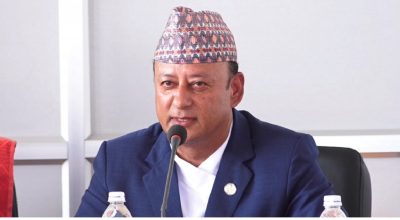
We, Nepalese people, take pride in claiming us to be the citizen of an agrarian Himalayan nation. Ever since the practice of financial planning and budget allocation introduced in Nepal the agriculture sector got the highest priority in terms of budget allocation. The establishment of a District agriculture office in all the existing districts also gave new hope to the peasants.
Moreover, the government established an agriculture development bank in all the districts to facilitate the farmers in their farming. The government also launched a Small Farmer Project to further facilitate the local farmers. Trillions of rupees entered Nepal in the name of poverty alleviation and billions of it returned back to the main source. The agriculture ministry used to exercise its power through the agriculture department, regional agriculture directorate, district agriculture office, and finally, local service centers in the past, and all of them used to enjoy the national fund as much as they could in the name of agriculture development. But the tragedy with all of us Nepalese is that neither we are self-sufficient in food grain nor in vegetables.
The same case we can find in animal husbandry. Ever since the concept of district veterinary office came into practice a large amount of money has entered Nepal in the name of veterinary development. Farmers can have a subsidized loan from the banks to purchase domestic cattle. No doubt, they borrow the money from banks but the money is spent in maintaining household expenses. Banks do have concern only over their investment and they want the assurance of payback. There is no mechanism to monitor whether the loan has been utilized properly in a determined field. As a result, we Nepalese have been ritualistic farmers. The central bureau of statics takes census in this area but God knows to what extent the printed data are true. We have become a farmer theoretically but pragmatically we are none. We have denied our local products like maize, millet, wheat, barley, and so on. They are given to cattle. We take pride in the purchased sack of rice grain but ignore its quality.
There is no actual data with the government about the money people pay for vegetables that come from India. Indian Inion and potato have the largest market in Nepal because without each Nepalese kitchen seem to be incomplete. Every year Nepalese people face an acute shortage of potato, onion, and garlic. The dealers make undue profit compelling customers purchase at a high price. With each price hikes the industry and commerce minister visit here and there with his squad to delude people as if they are doing something great for the people. They penalize sometimes a local grocer but shut up their eyes while they approach the dealer who creates an artificial shortage and hikes the price irrationally.
After the government of India imposed a ban over Onion export, Nepal faced an acute shortage of it in its local market. The importers and whole-sellers immediately concealed bags of Onion and created an artificial shortage. The minister for industry and commerce staged a drama visiting Kalimati based vegetable sales centers and took action against few vendors but shut his eyes towards big dealers and whole sellers. Every year we face Onion shortage but the government does not have any plan to grow more Onion. The government budget every year mentions with hue and cry that it will determine the pocket area for the production of Onion and allocates budget too, but no one exactly knows where the allocated money goes and who are the beneficiaries. The authority and officials concerned have become blind and deaf to this concern. Who can stop market anarchy? How long should people suffer?
The question comes why India made such a haste decision to impose a ban on onion export. Does it have any connection with Nepal or other neighboring countries? Is it merely an effort to trouble Nepalese as well other people whose kitchens are tasteless in absence of Onion? Or, Does India have a low production of Onion to suffice its citizens? Festivals are about to knock at the door of each Nepalese. They need more onion. India too knows this reality. Why should we curse India since our government is too irresponsible towards the wellbeing of its citizen? What is this non functioning so-called agriculture offices doing? These questions demand a proper answer but, who is ready to address?
Now the time has come to bring substantial change in our food behavior. Why don’t we try to cut more onion from our daily menu? Even without it we can prepare delicious vegetables and meat. But this is not the permanent solution. Our tong has become habituated in it and our mentality has become so rigid that we are not prepared to cook anything without onion in our kitchen.
The agriculture ministry might be busy in settling the traditional pandemic of fertilizers. An ideologue turned leader of agriculture, Ghanshyam Bhusal ji has been missing himself in the chunk of anarchy within it and his effort to come out of it will be a Herculean task. The question of whether Bhusalji will be able to break the snare spread by Mafias has become the prime one. We can still expect something good and new from him since his entry to this bureaucratic entanglement was to do something than to grab material well being, ride slippery cars, and gradually degrade his intellectual popularity. His ministry should take immediate action to initiate farmers in cultivating more potatoes and onion so that we can rely on our own products if not export.
There is lack of collaboration between agriculture ministry and industry and commerce ministry. Why doesn’t the leadership of both ministries make a mutual effort to avert the present onion crisis? Does it suit the agriculture ministry to observe silence in such a moment? It has to come up with a concrete plan and strategy to inspire farmers in onion cultivation. Where is its slogan of a special pocket area? Is it in the pocket of high profiled officials or in the mafia’s pocket? Does it have courage enough to make sure that the grants provided by PACTS like projects really went to the determined area and farmers’ life got substantial change? Can Bhusalji make a study of how many student leaders within and out of his party got the fund under the name of alleviating poverty? How many of them have agriculture farms, animal farms, and fisheries? Who pays attention to their sky -scrapping buildings in Kathmandu and in urban and semi-urban areas of Nepal?
The current price hike will make no difference to the leaders and well to do people but it has a significant meaning for a poor one who has to cover his shame under a compulsion. Where are the so-called leaders of civil society and students? Have not they heard of this artificial shortage and unnatural and irrational price hike? May be they are trying to show their image on the television screen.
Unless the government and the authority concerned to make a pragmatic policy in the agriculture sector, our condition of dependency on everything including onion, potato, and garlic will keep on expediting and people will have to suffer more from acute artificial shortage and unnatural price hike.








प्रतिक्रिया दिनुहोस्